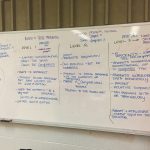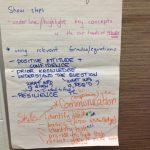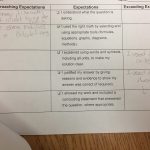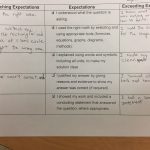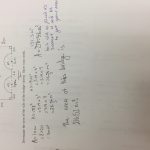Students registered in Grade 9 or 10 math are involved in the assessment continuum utilizing questions similar to EQAO open response questions. Students completed an open question with a focus on problem-solving. Success criteria were co-created and translated to a single-point rubric for use by students and teacher with a focus on the next best move to improve student achievement with regard to problem-solving and self-assessment. The single-point rubric is a tool of continual reflection throughout both student and teacher learning. In small groups, students looked at anchors for EQAO questions with levels removed and placed them on a continuum to discuss what would bump each solution, with regard to the success criteria, to the next level. Students continuously used the single-point rubric and success criteria to assess their own work. Teachers modelled giving appropriate feedback with regard to task feedback or process feedback. The process continued with students starting to give their next best step to improve their own work. The work will be continuing with students self-assessing their own work and the teacher deciding on which instructional strategies would be beneficial as a whole class or for small group instruction. For students in Grade 9, they will use this process with an EQAO practice test before the actual EQAO. Students who have assessed their work at Level 1 or 2 will then receive individual remediation.
Team Members
Terri Kraynick
Hamilton-Wentworth District School Board
Leanne Schaap
Hamilton-Wentworth District School Board
Chris Brady
Hamilton-Wentworth District School Board
Elizabeth Theodoropoulos
Hamilton-Wentworth District School Board
Adrianna Cassuccio
Hamilton-Wentworth District School Board
Dragana Maric
Hamilton-Wentworth District School Board
Professional Learning Goals
By the end of this project, teachers:
- had a guide to move students to become self-regulated
- had a guide to move students to become proficient at self-assessing their own work in math
- had a better understanding of the assessment continuum
- worked through the learner process themselves
- collaborated with other teachers on creating success criteria for individual task and used those criteria to moderate the EQAO questions
- determined the type of feedback necessary for individual students to improve their responses
- developed instructional strategies to help individual/small groups of students with their indicated area of need
Activities and Resources
- Creation of a baseline (pre- and post-) survey to see how students feel about identifying success criteria and then assessing their own work as well as one for teachers
- Problem-solving diagnostic for success criteria creation
- Identification of EQAO questions that best lend themselves to the project
- Teachers working through the process of identifying success criteria for a given task
- Moderated marking of some EQAO questions using the success criteria as identified by the group
- Mid-semester reflection on how the process is working and making adjustments as necessary
- Identification of task feedback (feedback regarding the math) and process feedback (feedback regarding the problem-solving)
- Participation in the “5 Practices for Orchestrating Productive Mathematics Discussions” Adobe Connect Professional Learning Series
- Problem-solving utilizing VNPS (Vertical Non-Permanent Surfaces)
- Team teaching when utilizing unfamiliar instructional strategies
- Remediation with students who have identified their work on an EQAO practice test as not meeting provincial expectations
Unexpected Challenges
Throughout this project, we wanted to keep assessment in mind. The goal was to help students self-regulate and be able to self-assess their own work while using success criteria. Students struggled using success criteria appropriately when the math content was something they were not comfortable with. We had thought it would be enough for students to have one next step, but soon realized we needed to incorporate instructional strategies for students to develop math talk and greater comfort with the material. We decided to employ small group instruction, problem-solving and math discussion using the “5 Practices for Orchestrating Productive Mathematics Discussions” and other strategies from the Math 4 the Nines website.
Enhancing Student Learning and Development
As students develop skills to use the success criteria and co-create success criteria, they will develop reflection skills to monitor their own achievement. Students will become better at assessing their own achievement with the use of co-created success criteria and transfer these skills from EQAO questions to all types of problem-solving questions in all subject areas. This is about students being independent learners and self-assessors as they progress through life.
By both the teacher and student identifying the next best step for the student, there was a need to explore instructional strategies to fulfil the identified need. Students were exposed to additional methods of solving problems while collaborating with other students. This allowed students to make connections between their initial method of solving and other methods, and then reflect on becoming a more efficient problem-solver.
Teachers will be able to measure the enhanced student learning by the quality of work being submitted by the end of the semester when compared to the beginning of the semester.
Sharing
Both administrators and the board consultant are sharing their learning with new math school teams across the board by having teams go through the process. Math teams are involved in facilitating their own team’s learning through this process. Our board is split into five families of schools with two to three secondary schools within each family. Gradual release to teachers to continue this process as departments and course teams would be an asset to building capacity and sustainability.
The benefit of this comes from continual use of the single-point rubric within a problem solving-based classroom environment.
We have been contemplating creating a presentation on how we might run a session (for our math teams and/or OAME) regarding setting the classroom environment for problem-solving as a way of learning math. The target audience would be math teachers who are incorporating problem-solving at all points within the learning – as an inquiry, action and consolidation of the math – but would like their students to become more self-regulated when assessing their own work. For teachers to value the importance of feedback within problem-solving, they must experience the process of answering a problem-solving question and then going through the creation of the success criteria/single-point rubric. Providing student work would then allow teachers to think about what the student’s next step are and then create one piece of feedback for the individual. Within this presentation, we would then talk about the need for instructional strategies and the connection to the VNPS and the 5 Practices resource.
Project Evaluation
We were able to connect this project with work we had been doing with problem-solving which made it more successful. If we had not connected it to problem-solving, then the reach of the project would only be for Grade 9 math teachers with their students writing EQAO at the end of the semester. Problem-solving makes it relevant to all math classes.
Looking at the professional learning goals, we used anecdotal data to help determine success with this project.
Teachers felt students were becoming better at using the success criteria more thoughtfully when determining if they were approaching, reaching or exceeding the expectations.
Teachers were also able to clearly create success criteria with their students and use this continuously throughout the semester. Teachers felt modelling the use of the rubric and the types of feedback for students was an important step before students could effectively do this themselves. We now know that it is a process where we should have followed a slower trajectory with teacher modelling, guided release and then finally students could use the tool independently.
Students told teachers, through an electronic survey, they felt more comfortable determining where and when their work needed improvement but were unable to state how to improve the math that was used. This was the reason we decided to start looking at forming groups and using the 5 Practices resource so we could help build the knowledge that was already within the classroom. Next time, we would start with the group work for a math topic throughout the process of learning and then move to individual assessment.
Resources Used
EQAO Anchors and Open Response Questions
5 Practices for Orchestrating Productive Mathematics Discussions
(Stein & Smith, 2011)
Math 4 The Nines – Summer Institute (2016).
The Ontario Math Curriculum: Grades 9 and 10. (2005)
http://www.edu.gov.on.ca/eng/curriculum/secondary/math910curr.pdf
Learning for All: A Guide to Effective Assessment and Instruction for All Students, Kindergarten to Grade 12. (Government of Ontario, 2013)
http://www.edu.gov.on.ca/eng/general/elemsec/speced/LearningforAll2013.pdf
Resources Created
These resources will open in your browser in a new tab, or be downloaded to your computer.



